|
This second Blu-ray volume of the BBC’s much-loved Ghost Stories for Christmas films effectively completes the set, containing as it does the final five entries in the original run of this once-a-yuletide series. The first three are once again based on short stories by that master of the supernatural, M.R. James, while the final two are original screenplays, the first by Clive Exton, the second by John Bowen, both of whom are writers of considerable repute. All except the final tale were directed by series maestro, Lawrence Gordon Clark.
All have had the picture and soundtracks remastered for this set, and all have new commentaries by noted experts in their field who also happen to be enthusiastic fans of these films. The introductions by director Clark have been carried over from the previous DVD releases, but have been joined by a new video essay, plus two later entries into the Ghost Stories series, which are also based on stories by M.R. James, which effectively makes this a seven-film set.
I should note that due to how far behind I currently am with my submissions for this site, my reviews of the principal five films in this set have been updated from my coverage of the earlier DVD releases – hence their brevity – but everything specific to this Blu-ray release is new to this review.
| THE TREASURE OF ABBOT THOMAS (1974) |
|
| |
|
| |
‘Startled as I was, I looked round after him, and saw him stand for a minute at the top and then walk away a few yards. Then I heard him call softly, "All right, sir," and went on pulling out the great bag, in complete darkness. It hung for an instant on the edge of the hole, then slipped forward on to my chest, and put its arms round my neck.’ |
| |
The Treasure of Abbott Thomas by M.R. James |
For a good part of its running time it would, I think, be fair to describe The Treasure of Abbot Thomas more as a detective story than a tale of the supernatural. I'd even go as far as to suggest that the investigative elements are, on the whole, more effectively realised than the ghost story that they only subtly suggest and belatedly give way to.
The film begins with an almost orgasmic séance being conducted by medium Mrs. Tyson (Sheila Dunn) and her husband (Frank Mills) on behalf of the recently widowed Lady Dattering (Virginia Balfour). Its failure, claim the Tysons, is likely due to the cynicism of Lady Dattering's son Peter (Paul Lavers), who is a scholar of the learned and level-headed Reverend Justin Somerton (Michael Bryant). Somerton is one of those rare film priests that I instantly take a liking to, a no-nonsense pragmatist who agrees to attend the next séance because he is "interested in all forms of the higher silliness" and who smartly exposes the Taylors as frauds. How could you not warm to this man? It's Somerton who tells Peter about the titular Abbot Thomas, a self-proclaimed alchemist who was condemned as a charlatan and who is reputed to have hidden a large quantity of gold coins somewhere in the monastery. In the process of translating a document from Latin, the two men stumble on a clue to the location of this treasure, one that leads to a cryptic message on a stained glass window.
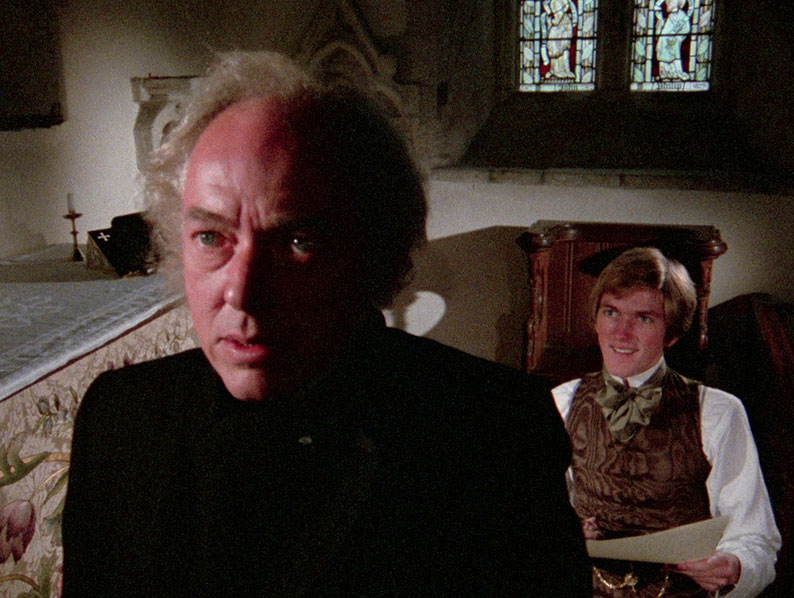
There's an almost Holmesian quality to Somerton and Peter's investigation, which peaks with the discovery of the hidden message and their dogged attempts to decode it, which is covered in a splendidly executed montage that screenwriter John Bowen apparently disliked. So well handled is this process and so convincing the performances of Bryant and Lavers that there were times when I forgot that I was watching a ghost story at all. Aside from Somerton's brief encounter with his own crippling vertigo on the monastery ramparts, the signs that the story will take a supernatural turn are teasingly oblique – a wine stain on a drawing, an indistinct shape on a photographic negative, a monk who may or may not be eavesdropping on their discussion. We're approaching the climactic scene before we learn, rather suddenly, that the treasure is reputed to be spiritually protected.
What follows is in some ways a condensed re-tread of the cautionary tales told in Whistle and I'll Come to You and A Warning to the Curious, where the unearthing and removal of a previously buried object sees the treasure-hunter pursued and traumatised by a ghostly guardian. But the cackling Abbot here is no match for the more indistinct horrors of Whistle's ill-defined spectre, and the treacly goo that precedes him and pursues the thief back to his room is no substitute for the multi-tentacled horror of James’s original (which I’ll admit would have been nigh-on impossible to realise convincingly on the budget that this film was probably made on). Thanks to the quality of this HD restoration, it’s become clear how handsomely and atmospherically shot a film this is (full marks to cameraman John McGlashan), with the handling of the second séance and Somerton's torchlight journey through the catacombs notable standouts on this score. The story also concludes on a splendidly chilling note, with a perfectly timed cut to black that leaving us to speculate on just what happened next to the character in question.
| |
|
| |
‘There is very little light about the bedstead, but there is a strange movement there; it seems as if Sir Richard were moving his head rapidly to and fro with only the slightest possible sound. And now you would guess, so deceptive is the half-darkness, that he had several heads, round and brownish, which move back and forward, even as low as his chest. It is a horrible illusion. Is it nothing more?’ |
| |
The Ash Tree by M.R. James |
Following the death of his uncle, Sir Richard takes up his new post as the squire of the vast Castringham Hall estate. The exterior of the Hall is dominated by a large ash tree, a plant that Richard is advised to have cut down to prevent its roots from damaging the Hall's foundations. Whilst touring the estate, Richard discovers that animals are being inexplicably found dead, and begins to be haunted by visions of his ancestor, Sir Matthew, whose damning testimony saw a woman named Anne Mothersole condemned and executed as a witch.
Despite the characteristically gradual manner in which this story unfolds, there are twin hooks here in the shape of the finely judged performance of Edward Petherbridge (so wonderful as Newman Noggs in the Royal Shakespeare Company production of The Life and Adventures of Nicholas Nickleby) as both Richard and Sir Matthew, and confident direction by series regular Lawrence Gordon Clark. There's an almost sleight-of-hand economy to the storytelling here, with scenes and locations linked by unbroken conversation and the extent of the livestock sickness shown almost in passing, while the year in which the story takes place is established by a single component of Richard's literature collection.
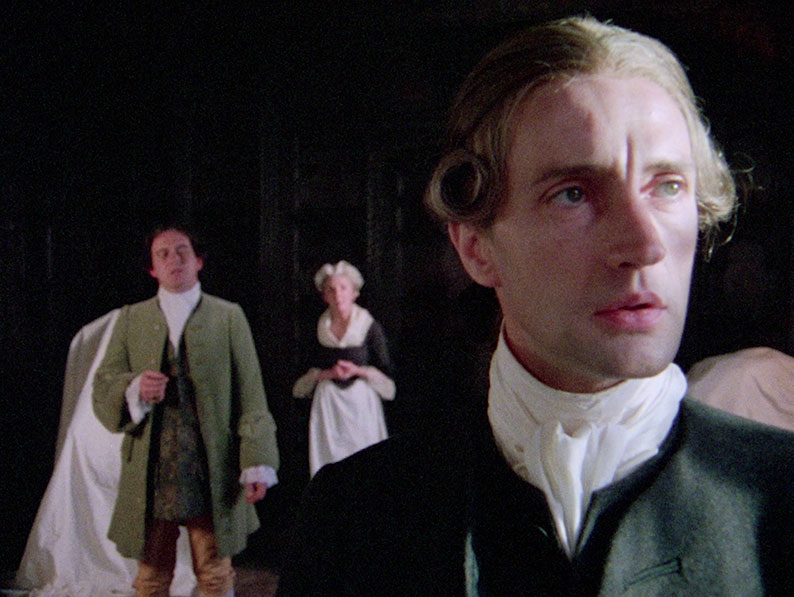
Particularly impressive is Clark's handling of the dual timeline structure, with Sir Matthew's story initially unfolding as brief visions (or perhaps inherited memories?) that become more substantial as the film progresses. There are no date captions or voice-over clues to these temporal switches here, the trips into the past sometimes signalled only by differences in costume and hairstyle, coupled with subtle alterations in vocal delivery and language.
The significance of the titular ash tree is downplayed until the climactic scenes, but hovers tantalisingly in the background whenever the suggestion is made that Richard should have it cut down. Only towards the end, when Richard moves into the room in which his great uncle slept, does the real significance of the title really hit home. It's also here that Clark and writer David Rudkin (who also wrote the superb Penda's Fen for Alan Clark the previous year) take a real risk by visualising creatures that were indistinctly described in the original story, particularly given the small budget with which they had to work. But while they don't stand up to close inspection, when only fleetingly glimpsed they are actually quite creepy, and a wide shot in which we can just make out a number of them together in the moonlight – an almost exact recreation of a passage in the story – is genuinely unsettling. But the best frisson of all is delivered by the handling and the timing of the final cut to black, which references an earlier dialogue exchange and is every bit as sharp and unexpected as the one at the end of No Country for Old Men.
| |
|
| |
‘“One moonlight night,” said the man, “I was sitting here, when I heard a voice cry, ‘Halloa! Below there!’ I started up, looked from that door, and saw this Some one else standing by the red light near the tunnel, waving as I just now showed you. The voice seemed hoarse with shouting, and it cried, ‘Look out! Look out!’ And then again, ‘Halloa! Below there! Look out!’ I caught up my lamp, turned it on red, and ran towards the figure, calling, ‘What’s wrong? What has happened? Where?’ It stood just outside the blackness of the tunnel. I advanced so close upon it that I wondered at its keeping the sleeve across its eyes. I ran right up at it, and had my hand stretched out to pull the sleeve away, when it was gone.”’ |
| |
The Signal-Man by Charles Dickens |
Charles Dickens, it has to be said, is not widely remembered as a ghost story writer, which is a tad ironic when you consider that his 1843 novel A Christmas Carol includes three of the most famous ghosts in literary history. He did, in fact, write a number of supernaturally themed short stories, the most chilling of which was The Signal-Man, which was inspired by personal experience and first published in the 1866 Christmas edition of the author's own periodical, All the Year Round.
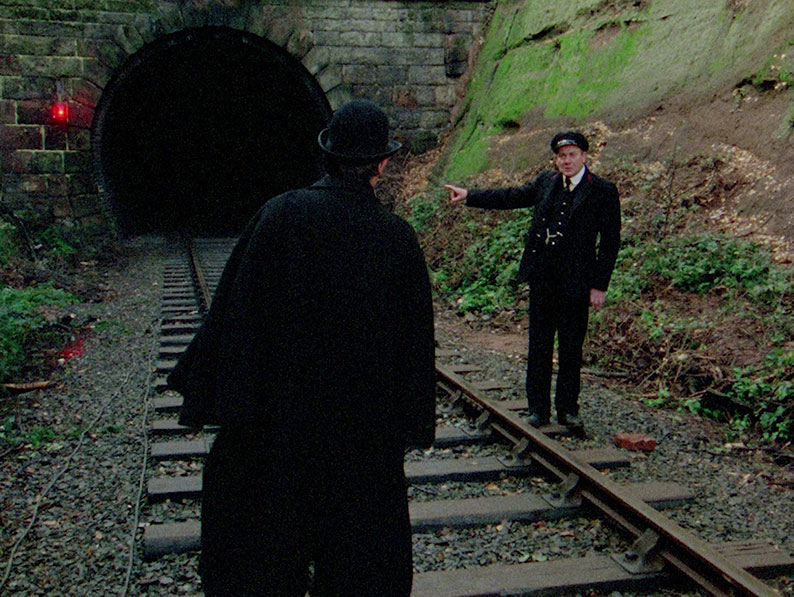
The film, like the story, begins with an unnamed Traveller (Bernard Lloyd) calling out to a lone Signalman (Denholm Elliott), who is standing by the track at the mouth of a tunnel in the viaduct below. At first, the worried-looking Signalman fails to reply, then he points the way to a path that will allow the Traveller to safely descend. Once the Signalman's curious apprehensiveness abates, the two men retire to the warmth of the signal box interior, where they converse until late into the evening. As the Traveller departs, he agrees to return the following evening to continue their conversation, when the Signalman promises to reveal the source of his anxiety.
On the Traveller's return, the Signalman informs him that the manner in which he first hailed him was identical to the call of a mysterious apparition, one whose every appearance has been followed by a tragedy. The Traveller attempts to rationalise what he is told as a combination of coincidence hallucination, but the Signalman then reveals that the figure has recently begun to reappear, and he is now fearful that another terrible event will soon occur.
Apparently inspired by both the Clayton Tunnel collision of 1861 and the Dickens' first-hand experience of the Staplehurst rail crash four years later, The Signalman is without question one of the strongest films in the Ghost Stories series, and remains today one of the finest of all televisual tales of the supernatural. The story was adapted by Andrew Davies – who was later to pen such luminary television works as A Very Peculiar Practice, House of Cards, and several adaptations of literary classics, including two Dickens novels – and benefits greatly from being faithful to the source story, right down to the period formality of the dialogue.
Essentially a two-hander, both of the lead actors here are both first-rate. As the unnamed Traveller, Bernard Lloyd is solidly convincing in his self-assured rationalism, but the real prize is a beautifully nuanced performance from Denholm Elliott as the Signalman of the title. From the moment we first see him in face-revealing close-up, his inner fear and torment are clearly evident, and subtly underscore every subsequent verbal exchange. This is particularly effective when the Traveller assures the Signalman that he will return for a third visit, prompting a response in which gratitude is laced with quiet desperation.

Everything clicks here, with the writing and performances working in complete harmony with David Whitson's atmospheric cinematography, the telegraph-wire tones of Stephen Deutsch's minimalist electronic score, and Clark's understated direction, all to captivating and genuinely haunting effect. It even scores on a subtextual level, subtly exploring the psychology of social isolation and grimly commenting on the destructive potential of the industrial age.
Stigma was the first film in the Ghost Stories strand not to be adapted from a previously published short story, and the first to be set in modern times. A degree of continuity with the previous films is provided by director Lawrence Gordon Clark, whose last film for the series this turned out to be. The original screenplay is by Clive Exton, whose busy CV includes screenplays for such prestige works as Night Must Fall (1964), Isadora (1968) and 10 Rillington Place (1971). In Stigma, his focus is more on effect than cause, one whose late film revelation lacks the sting of surprise it ideally needs and has previously been teasingly building up to.
Katherine (Kate Binchy) and her daughter Verity (Maxine Gordon) return from a shopping trip to their recently purchased country cottage, where workmen are in the process of clearing the grounds. Their final obstacle is a large flat stone, one that proves too heavy to lift with their current machinery. In their attempt to dislodge it they lift the stone just enough for something unseen to escape from beneath it and invade Katherine's body, which temporarily places her in a trance-like state. A short while later, she discovers that her clothing is heavily stained with blood, but close and panicky examination reveals no trace of a wound of any kind on her body.
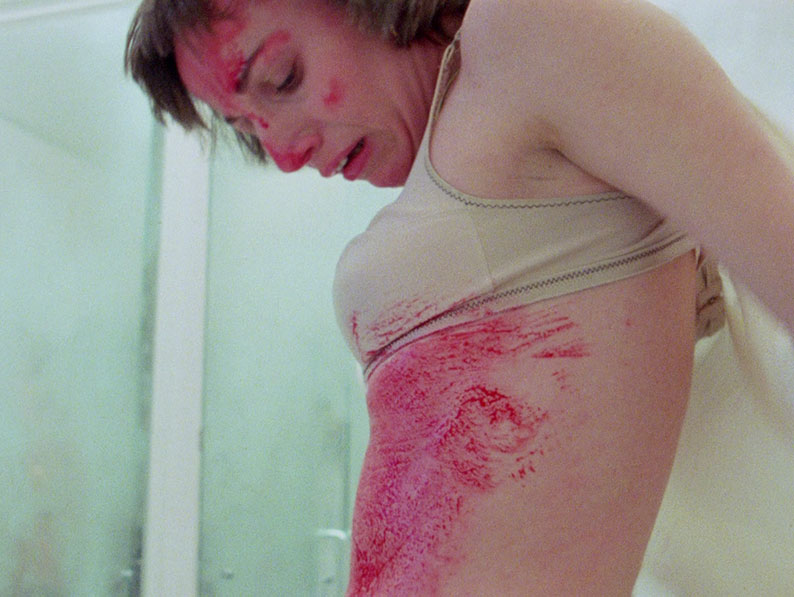
And that, for the most part, is the meat of the story. What holds the attention from this point on is Katherine herself, specifically her growing terror at what appears to be happening to her body, something actress Kate Binchy communicates with sometimes unnervingly convincing aplomb. Pleasingly, her affliction proves to be not the result of some delusion on her part but a real physical issue, one that terrifies her husband Peter (Peter Bowles), and is visualised as a unnervingly convincing make-up effect.
The lack of narrative substance and the recycling of a couple well-worn genre motifs do make themselves felt, with the revelation about just what has lain under the stone for so long being too predictable a concept and too randomly deployed to deliver the sorely needed gut-kick of surprise. But Stigma is still a well-made, solidly acted and eerily unsettling work, albeit one whose lack of narrative depth makes it feel a little like the first draft of a longer and more complex tale to come.
The final film in the original Ghost Stories strand was the first after Whistle and I’ll Come to You not to be directed by Lawrence Gordon Clark. It remains the oddest and most narratively oblique of the series, never openly explaining the nature of its horror, in the process leaving itself open to multiple interpretations.
Recently separated Paul (John Stride) has come to what appears to be an upmarket health spa, where he hopes to relax and come to terms with the pain of his recent marital breakup. The spa is run by the über-polite (and possibly incestual) brother and sister duo of Clovis (Geoffrey Burridge) and Jessica (Elizabeth Romilly), who devote a disproportionate amount of their time to ensuring Paul's wellbeing. Deep in the spacious grounds grow two unusual flowers that are impervious to hardship and have an intoxicating scent, behind which sits the spa's famed ice house, which Clovis and Jessica encourage an initially apprehensive Paul to investigate. Over the following nights, Paul's sleep is disturbed by a small hole in the window of his room, one that grows and shifts in shape to resemble that of the strongly scented flowers, and when he investigates the ice house one evening, he makes a deeply disturbing discovery.

Despite being theoretically part of a community, Paul is effectively isolated from the moment we first meet him. The other guests appear to sleepwalk through their days, and never engage Paul or each other in conversation. Clovis and Jessica aside, the only person with whom Paul is able to converse is a young masseur named Bob (David Beames), whose intermittently cold hands he describes as having "a touch of the cools," an affliction that apparently affects all spa employees. One day, Bob unexpectedly asks for Paul's help to leave, but their conversation is interrupted by the sudden appearance in the room of Clovis. The following morning, Paul discovers that Bob has disappeared.
So what, you might wonder, is going on here? To be honest, it's something you might still be pondering long after you've ejected the disc and placed it safely in its case. Is this horror, metaphorical drama, or even science fiction? There is, after all, an almost Twilight Zone-ish feel to the spa and its guests, who drift through their days in a semi-hypnotic state, while Paul's conversations with Clovis and Jessica are peppered with oddly mannered lines. At times there is almost a sense that they have been unknowingly cast in a Samuel Beckett play being rehearsed in the afterlife.
This does tend to place some distance between the audience and the characters on screen, whose actions and eventual fate I found myself observing rather than emotionally engaging with. But there is still a steely creepiness that pervades every scene, with the artificiality of the upbeat surface detail – personified in Clovis's ad-man smiles, psychiatric nurse pleasantries, and Aryan looks – clearly masking something sinister and unspoken. But what, exactly? The lack of narrative clarity has clearly and understandably frustrated some viewers, and certainly had me scratching my head the first time around. But give it a second look, and a few intriguing pointers start to become visible, quietly suggestive sentences tucked away in the dialogue, often disguised as almost throwaway lines.

A bold and intriguing experiment from director Derek Lister and respected writer John Bowen, The Ice House is strong on suggestion and disquiet but teasingly short on explanations. While I found it quietly compelling, it seems likely that such intriguing ambiguity will not work for some. Others, quite reasonably, might wonder if this particular entry into the BBC's Ghost Stories strand is actually a ghost story at all.
All of the films in this collection have been remastered in 2K from the 16mm camera negatives held by the BBC Archive and are presented in their original aspect ratio of 1.33:1. Unusually for a Blu-ray, the films are presented in 1080i rather than 1080p. I was originally under the impression that this was due to the BBC using the 1080i standard for some time after HD became a production format standard, but received the following correction on this score from Michael Brooke:
A technical point - the optimum setting for this material would be 1080p/25 (befitting a progressive scan of film elements playing at the UK PAL TV framerate of 25 frames per second), but sadly that isn't recognised by the European Blu-ray specs, so they have to use 1080i/50 as a workaround. But the end result is exactly the same as far as the end viewer is concerned, with no visible interlacing.
As you would hope, the image quality on all five films shows a marked improvement over their DVD predecessors, with noticeably crisper detail definition and more lifelike colour, with some primary colours – the darkroom red in The Treasure of Abbot Thomas is a fine example – looking particularly vibrant here. Black level are solid throughout, and the contrast is attractively balanced when the light levels are good, often punchy when areas are cast into shadow. Although strong in other respects, The Signalman just occasionally falls a whisper short of its companions, with slightly coarser film grain (it’s quite possible that the night shooting required a faster film stock) and the occasional moment where the image quality drops just a tad (two slowed-down shots during the second accident, for instance). It’s still a significant step up on the DVD, and is otherwise a most impressive restoration and transfer. Oddly enough, for me the best-looking films in this set are the oldest two, The Treasure of Abbott Thomas and The Ash Tree, whose imagery has scrubbed up wonderfully and whose level of detail and image robustness are consistently impressive. Film grain is visible on all five titles, but feels finer than on the DVD transfers, particularly on the first two films.
The audio tracks for all five films have also been remastered from original 16mm magnetic tracks, and are presented here in Linear PCM 2.0 mono. Although the tonal range of the dialogue is slightly narrower here than on the later, digitally shot entries (two examples of which are included in this set), the clarity is still first rate here and the audio quality on all five titles is superior to their DVD equivalent, something particularly evident on the sound effects and music. I recall hearing no trace of any damage or wear.
Optional English subtitles for the hearing impaired have been included for all five films, and on A View From the Hill, Number 13 and Ghost Stories for Christmas with Christopher Lee in the special features. That said, fellow reviewer Gary Couzens made the following observation:
There is an error in the subtitling for Number 13 where the creature of East Anglian folklore, the Black Shuck, is rendered as the "black shark". This error has been carried over from the previous BFI DVD release in 2012.
DISC 1
Commentary for ‘The Treasure of Abbot Thomas by Simon Farquhar
Writer and broadcaster Simon Farquhar takes an enthralling look at what he regards as one of the most interesting films in the Ghost Stories for Christmas series, delivering a commentary that is a blend of the factual, the observational, and the analytical. He’s clearly interviewed some of the personnel involved, and thus has stories related to the shoot that I’ve not heard elsewhere, and while he praises many aspects of the film, he’s also not above criticising elements that he feels don’t quite work. There is specific detail on writer John Bowen, director Lawrence Gordon Clark and score composer Geoffrey Burgon, and he shares a persuasive theory over what makes the first two entries in the series feel different from the films that followed. There’s also an interesting discussion on why Christmas should be a time to tell ghost stories, a question that rears its head in one of the later commentaries.
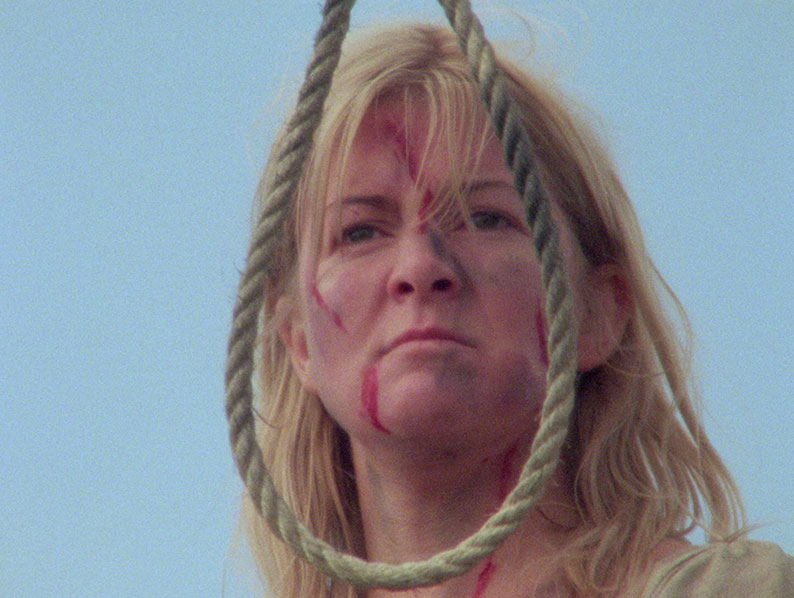
Commentary for ‘The Ash Tree’ by Jon Dear, incorporating material from Johnny Mains
Writer and TV historian Jon Dear, who is currently working on a book about the BBC’s Ghost Stories for Christmas (which I’m keenly looking forward to), apparently stepped in at the last minute after the original commentator, author and editor Johnny Mains, was taken ill. We wish him well. Frankly, given the research that Dear must have already done for his book, coupled with his knowledge of and passion for these films, you couldn’t really ask for a better substitute, and he does incorporate points made by Mains in his notes into his assessment. He provides information on the actors, screenwriter David Rudkin, the M.R. James short story on which the film is based, and even has details on the origin of the name Mothersole and the Ash tree and its significance in folklore.
Introduction to The Treasure of Abbot Thomas by Lawrence Gordon Clark (10:38)
Regular series director Lawrence Gordon Clark here talks about lead actor Michael Bryant, the problems of securing the main location (no easy job a year after Pasolini had shot part of The Canterbury Tales there), the changes made to M.R. James's original story, his disappointment at how the climatic horror elements played, and his relationship with screenwriter John Bowen.
Introduction to The Ash Tree by Lawrence Gordon Clark (8:05)
For his final M.R. James adaptation for the BBC, Clark talks about the problems of finding the right location (there's an interesting post-shooting story attached to this) and his delight at being able to work with the writer of Penda's Fen. Surprisingly, he regards this as one of his less successful M.R. James adaptations, and believes that's it's not as scary as it should have been.
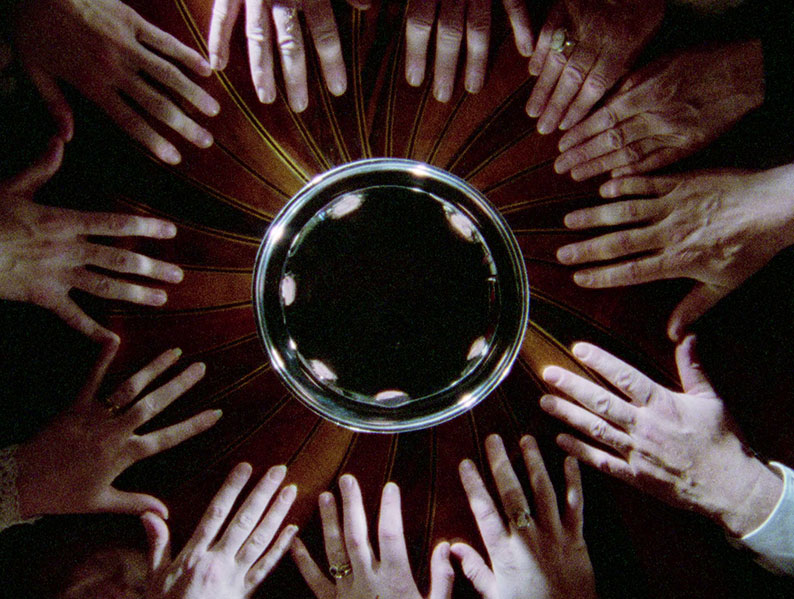
Spectres, Spirits & Haunted Treasure: Adapting M.R. James (16:30)
A newly commissioned and well-presented video essay by Nic Wassell that examines the classic BBC adaptations of M.R. James stories in this series, and particularly how closely they stick to their source material. He identifies The Ash Tree as the most faithful, and The Treasure of Abbott Thomas as the one that diverges the most, though does praise its ambition in moving beyond the story on which it is based.
DISC 2
Commentary for ‘The Signalman’ by Jon Dear and Mark Gatiss
Writer and TV historian Jon Dear is back for a commentary he was actually scheduled to do. This time, he is joined by actor, writer and horror enthusiast Mark Gatiss – who was also writer and director of several of the more recent entries in the series – for a captivating chat about what remains one of the best of the BBC’s Ghost Stories for Christmas films. They confirm that Denholm Elliot was director Lawrence Gordon Clark’s first and only choice to play the title character, and that filming had to be delayed to fit in with his schedule, meaning that shooting wrapped just six weeks before the scheduled transmission date. They also cannily suggest that to have included other characters would have impacted the film’s eerie air of solitude, and speculate on just what the ghostly figure is, as well as providing some detail on the filming locations and praising the use of sound and the spooky electronic tonalities of the score. Dear’s cry of “Oh…my…God...” when the ghostly white face is first shown in close-up is priceless, and Gatiss rounds things off splendidly with a well-deserved salute to the work of director Clark when he says, “Well done, Lawrence. A masterpiece.”
Commentary for ‘Stigma’ by Kim Newman and Sean Hogan
Author and critic Kim Newman is joined by writer and filmmaker Sean Hogan to discuss what they describe up front as one of the more controversial and atypical entries in the series. They praise it for its visual storytelling, its earthily realistic feel and the persuasive believability of lead actress Kate Binchy, but do note that standing stone and ‘townies move to the country’ stories were very common in the 1970s. They rightly claim that there is more blood in this film than all of the other Ghost Stories for Christmas combined, but trip up just slightly when Newman asks if this is the only one of the original films with nudity and Hogan responds with an emphatic “Absolutely!” – sorry chaps, but The Ash Tree has Stigma beat on that score. They cannily observe that what makes this more horrific than the stories that precede it is the fact that the lead character did nothing to deserve her grim fate, and they salute the still developing directorial skills of Lawrence Gordon Clark. They also praise the memorable closing helicopter shot, which Hogan amusingly suggests was “Clark’s final fuck you to the BBC.”
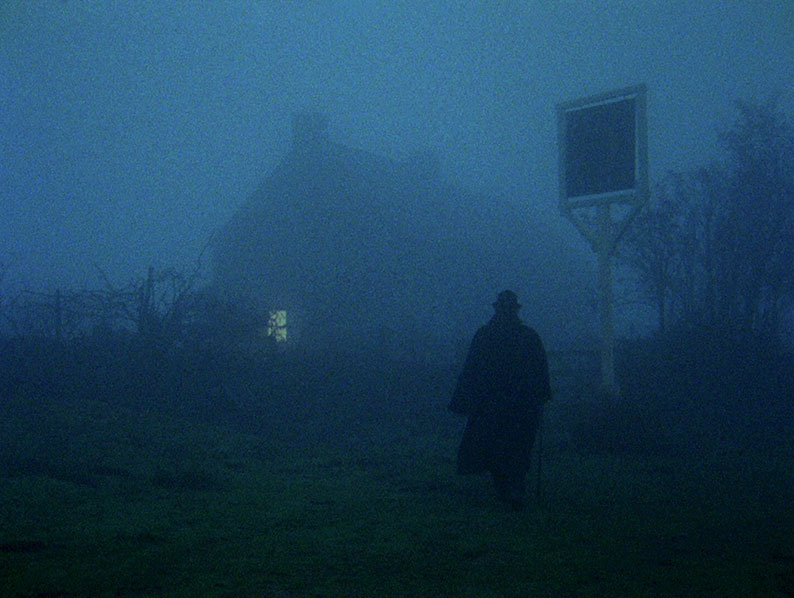
Introduction for The Signalman by Lawrence Gordon Clark (10:41)
Clark talks enthusiastically about what clearly remains a fondly remembered film, praising the work of writer Andrew Davies, cinematographer David Whitson and lead players Denholm Elliott and Bernard Lloyd (there's also an interesting titbit about Elliott not having learned his lines). His own analysis of the story, and particularly its subtext, is fascinating, and gives a good indication of why this film feels so thematically strong.
Introduction for Stigma by Lawrence Gordon Clark (8:45)
It's said that you can learn as much from what a person doesn't say as what they do say. With that in mind, you can read what you like into the fact that Clark spends half of this interview talking about his career in general and what remains his favourite work, the acclaimed political drama, Harry's Game. When he does focus on Stigma, he praises the performances and the fact that writer Clive Exton doesn't include stage directions in his screenplays, but remains uncertain where the story's malignancy comes from. And he was the director.
DISC 3
Commentary for ‘The Ice House’ by Kim Newman and Sean Hogan
Newman and Hogan return to talk about the last of the official run of the BBC’s Ghost Stories for Christmas, a film that Newman admits to having warmed to over several viewings and now regards as a fine piece of work. There is some discussion about the film and the actors, but the lion’s share of this commentary is devoted to screenwriter John Bowen and his canon of work as a screenwriter and novelist. Newman does identify the story here as a subtly developed vampire tale, and reveals that the lead character in Bowen’s 1984 novel The McGuffin was based directly on him when he was working as a film critic for the London listings magazine, City Limits (which I used to buy slavishly every week, I should note).
Ghost Stories for Christmas with Christopher Lee – Number 13 (29:20)
One of four episodes screened by the BBC in December 2000, also under the title of Ghost Stories for Christmas, in which Christopher Lee plays M.R. James in his role as provost of King’s College Cambridge, as he reads Number 13 to a small gathering of students on the night of Christmas Eve at the rail end of the 19th Century. If you’ve seen any of the others in this series – and there are two in the first BFI Blu-ray collection – you’ll know what to expect, but given Lee’s considerable talent as an arresting storyteller, that’s in no way a criticism. An entertaining listen peppered with illustrative cutaways, it also gives those who have not read the James’s story the chance to compare it with the 2005 TV adaptation also featured on this disc.
| A View from the Hill (2005) (39:01) standard definition 1.78:1 |
|
After a break of several years, this 2005 adaptation of the M.R. James story of the same title was the first film in a sporadic revival of the Ghost Story for Christmas strand. There appears to have been a conscious effort on the part of writer Peter Harness and director Luke Watson to recapture the essence of the early Lawrence Gordon Clark films, and despite the odd distracting burst of hyperactive editing, they come captivatingly close to achieving their aim. Changes are made to James’s original text, notably in the relationship between the lead character and his host, and more especially in the manner in which the story climaxes and concludes, but the core elements of the tale remain the same.

Historian Dr. Fanshawe (Mark Letheren) travels to the stately home of Squire Richards (Pip Torrens), whose collection of antiquities Fanshawe has been asked to catalogue and value. Shown to his room by the Squire’s grumpy manservant, Patten (David Burke), he discovers that lenses on his binoculars are broken, and asks his host if he has a pair that he could borrow. The Squire digs around in an old wooden crate and retrieves an old and seemingly hand-crafted pair, which he loans to Fanshawe to use during his stay. The two then go for a walk through the local woodland until they reach a hilltop clearing, and when Fanshawe looks across the fields through the borrowed binoculars to the site where the now ruined Fulnaker Abbey once stood, he sees what looks like the Abbey as it was in its heyday. Later that afternoon, he cycles to the former grounds of the Abbey to investigate further, but finds only a small collection of scattered ruins. On his way back to the house he gets a puncture, and as daylight fades, he becomes seriously spooked by strange noises and whisperings in the surrounding woodland. Night has fallen by the time he makes it back to the house, and when he sits down for dinner with the Squire, the previously taciturn Patten tells him a troubling tale about the origin of these particular eyeglasses.
A View From a Hill is one of M.R. James’s less widely known works (it’s certainly not in the first collection that I bought), but it bears a fair few of the author’s hallmarks, and there are strong similarities here to key early entries in the Ghost Stories for Christmas series. The basic premise of an academic who journeys to a rural location far from his home, and who inadvertently awakens supernatural forces through the acquisition of an old and possibly cursed artefact, is one you’ll also find at the core of more celebrated works like Whistle and I’ll Come to You and A Warning to the Curious.
Aside from a brief flashback involving Baxter (Simon Linnel), the clockmaker who constructed the binoculars, this is essentially a three-hander, and once again it’s the actors who really sell the story. There’s an intriguing edge to Mark Letheren’s performance as Dr. Fanshawe, whose constant uneasiness at his surroundings suggests a backstory that’s hinted at but never explored, one rooted in his possibly problematic relationship with his employer, Professor Wilson. I hugely enjoyed Pip Torrens’ often dryly humorous performance as Squire Richards, which intermittently has more than a whiff of Hugh Laurie’s Bertie Wooster about it (Torrens even sounds like Laurie at times). And then there’s David Burke, who for my money remains the screen’s finest incarnation of Dr. Watson and who is quietly excellent here as unpaid manservant Patten, able to communicate so much with a few short words or a single gesture – check out his non-verbal admonishment of the Squire on discovering that the wooden crate containing the binoculars has been opened.
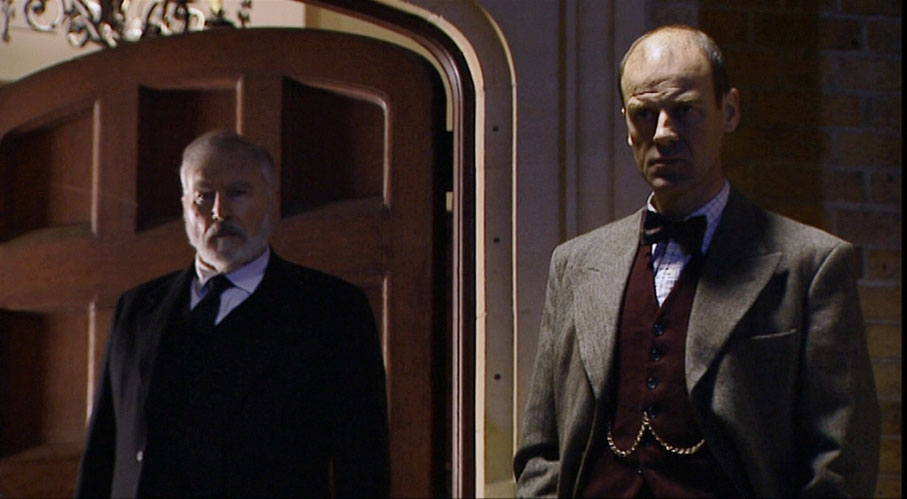
I’m aware that many fans of the initial run of Ghost Stories feel that the later works do not hit the heights of the Lawrence Gordon Clark films or especially Jonathan Miller’s extraordinary series precursor. And while it’s hard to disagree, this does risk undervaluing films such as this and its immediate successor, Number 13 (see below). Purists may disagree, but for me, the new climax and ending invented here by writer Peter Harness is an effective expansion on James’s more explanatory (but still creepy) original. Luke Watson’s direction is also commendable, squeezing tension out of Fanshawe’s uncanny woodland encounters, particularly in the final scenes, and creating a genuine sense of wonder when he finds himself transported inside the magically restored Abbey in all its golden grandeur.
A trailblazer this is not, and it’s never as unsettling or downright scary as the most effective moments in those earlier films. The woodland disturbances are certainly creepy, and the film nearly hits a horror home run with the appearance of a shadowy figure in Fanshawe’s bathroom, a moment whose effectiveness is then undercut by the perceived need to deliver a loud jump-scare. Overall, however, the film delivers the expected goods, and does so, for the most part, in a pleasingly understated manner.
| Number 13 (2005) (39:01) HD 1080i 1.78:1 |
|
Noted historian Professor Anderson (Greg Wise) checks into a hotel in an unspecified English cathedral town, to which he has been invited to authenticate historical documents found hidden in a wall in the cathedral archives. After being offered a selection of rooms, he settles on number 12 because it includes a desk at which he will be able to work, and to his surprise, the landlord Mr. Gunton (David Burke) requests that he settle his bill in advance because several previous guests have disappeared without paying. Once settled in, Anderson heads to the archive, and when the archivist, Mr. Harrington (Paul Freeman), temporarily leaves the room, the professor discovers a small sealed document secreted in the wall cavity in which the other documents were discovered. When he opens it, he finds it to be a crest-headed letter written in an ancient text and signed by a man named Nicholas Franken, a name that the elderly Harrington appears never to have heard of.
That evening while on his way down to dinner, Anderson meets his immediate neighbour, law firm employee Edward Jenkins (Tom Burke, David Burke’s son), a man whose accent and table habits the historian looks snootily down on. That night he is woken by loud male and female laughter coming from appears to be Jenkins’ room, noise that he silences by irritably banging on the dividing wall. As he returns to his slumber, the shadow of an unidentified figure appears on the wooden wall behind him.
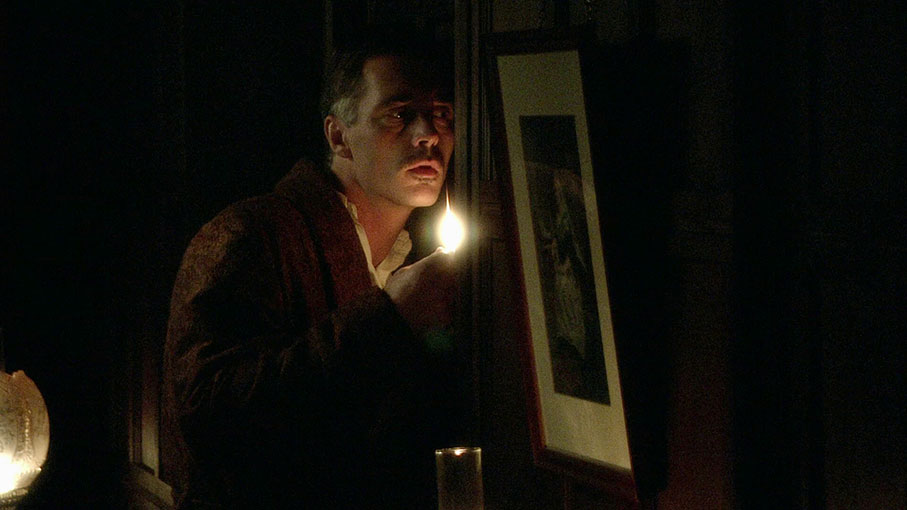
The following morning, Anderson notices that Jenkins’ room is numbered 14 and the hotel thus has no room 13, which he mocks as a remnant of outdated superstition*. After breakfast, he heads back to the cathedral archive, and discovers by chance a document in which a woman who was condemned as a witch claims that she was brought before the Devil’s emissary, whose name was Nicholas Franken, the author of the now mysteriously vanished letter. That night, Anderson’s sleep is once again disturbed by noises in the room next door, but when he heads into the corridor to investigate, he is startled to discover that between his and Jenkin’s room, a new door has appeared bearing the previously missing number 13.
As with View From the Hill, this 2006 BBC adaptation of the M.R. James story of the title takes its inspiration from the early films in the original Ghost Stories for Christmas series, and despite being shot on HD video in the 1.78:1 aspect ratio, as a period piece it feels a lot closer to The Stalls of Barchester than modern day-set Stigma and The Ice House. It’s nicely cast and very well acted, and atmospherically shot by cinematographer Ian Moss, with solid direction from Pier Wilkie, who acted as producer on A View From the Hill. Despite the relocation from Denmark to rural England, the script by Peter Harness adheres to the core elements of James’s original whilst expanding on them in sometimes effective ways, but not quite everything clicked for me. I remain unsure about the intended nature of the shadow on Anderson’s wall (if it’s meant to be a figure, I’m not convinced, but if it’s meant to be a shadow, why does Anderson never look round to see what’s casting it?), while the sight of what lies within room 13 prompted no more than a small shrug on my part. But I still enjoyed this, primarily for its acting and storytelling, even if one of the creepiest elements of the original story is so subtly communicated here that you might not even realise what has actually happened.
The Booklet included with this set is essentially a melding of the ones that accompanied volumes 3 and 4 of the original DVD releases of these films. I’ve no problem with this, as many will not have the DVDs, and all of the essays make for worthwhile reading. The Treasure of Abbott Thomas is examined by cinema curator at The Barbican, Alex Davidson; The Ash Tree by BFI television consultant Dick Fiddy; The Signalman by writer and television historian, Simon Farquhar; Stigma by author and associate professor in film and television studies at the University of Warwick, Helen Wheatley; while Alex Davidson returns to cover The Ice House. These are followed by credits for all of the films and the special features, and details of the restorations.
Another must-have for fans of the BBC’s Ghost Stories for Christmas films, this includes the final five of the original run, with the bonus of the first two of the series’ later revival. The films, newly restored, together with five terrific commentary tracks, a new video essay, a Christopher Lee M.R. James reading, and a booklet of essays, make this a belter of a Blu-ray release. Highly recommended.
|